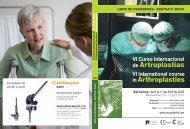cadera / hip - Active Congress.......
cadera / hip - Active Congress.......
cadera / hip - Active Congress.......
Create successful ePaper yourself
Turn your PDF publications into a flip-book with our unique Google optimized e-Paper software.
MARTES / TUESDAY<br />
78<br />
OUTCOME OF TOTAL HIP<br />
ARTHROPLASTY USING<br />
EXTENSIVELY POROUS-<br />
COATED COMPONENTS AT<br />
20-YEAR FOLLOW-UP<br />
C. A. Engh, MD<br />
P. J. Belmont, Jr., MD<br />
S. E. Beykirch, BS<br />
R. H. Hopper, Jr, PhD<br />
C. A. Engh, Jr, MD<br />
Anderson Orthopaedic Research<br />
Institute, Alexandria, VA, USA<br />
Introduction: Porous-coated total <strong>hip</strong> arthroplasty<br />
components were introduced with<br />
the hope that they would achieve durable<br />
biologic fi xation. The Anatomic Medullary<br />
Locking stem and TriSpike cup were among<br />
the fi rst porous-coated components used<br />
in North American. Patients from our initial<br />
clinical series using these components are<br />
now eligible for 20-year follow-up.<br />
Methods: Between October of 1982 and<br />
December of 1984, we performed 223 total<br />
<strong>hip</strong> arthroplasties among 215 patients using<br />
the Anatomic Medullary Locking <strong>hip</strong> system<br />
(DePuy). The porous-coatings on the cup<br />
and stem were achieved by sintering chromecobalt<br />
beads to a chrome-cobalt substrate.<br />
The mean age at surgery was 55 ± 15 years<br />
(range 16 to 87 years). Ninety-one patients<br />
(93 THAs) with less than 20-year follow-up<br />
are now deceased. The mean follow-up<br />
for the 130 remaining THAs is 21.1 ± 2.4<br />
years.<br />
Results: Forty-seven THAs have required<br />
component revisions. In 22 cases, the fi rst<br />
revision was limited to a liner exchange for<br />
polyethylene wear or osteolysis. Seven <strong>hip</strong>s<br />
with pelvic osteolytic lesions that measured<br />
at least 1.5 cm2 had loose cups at the time<br />
of revision. Three stems have been revised<br />
for aseptic loosening. Owing to the high<br />
incidence of wear-related revisions, Kaplan-<br />
Meier survivors<strong>hip</strong> at 20-year follow-up,<br />
using component revision for any reason as<br />
an endpoint, was 75 ± 7% (95% confi dence<br />
intervals). In contrast, survivors<strong>hip</strong> using<br />
stem revision for any reason as an endpoint<br />
was 98 ± 2% at 20-year follow-up. Survivors<strong>hip</strong><br />
of the porous-coated shell, using cup<br />
revision for any reason as an endpoint, was<br />
86 ± 5% at 20 years.<br />
Discussion: Despite revisions for wear-related<br />
complications in this relatively young<br />
patient population, the fi xation achieved with<br />
these porous-coated components remained<br />
durable through 20-year follow-up. Acetabular<br />
osteolysis has been associated with cup<br />
migration but femoral osteolysis has never<br />
resulted in stem loosening.<br />
EXTENSIVELY POROUS<br />
COATED STEMS: OUR<br />
GOLD STANDARD<br />
W. Paprosky<br />
Rush Arthritis & Orthopaedic Institute<br />
St. Luke’s Medical Center<br />
Chicago, Illinois, USA





